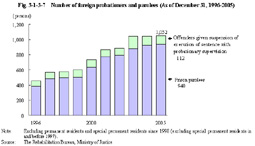| Previous Next Index Image Index Year Selection | |
|
|
4 Probation and parole supervision
Foreign probationers and parolees newly received in 2005 were 1,579, an increase of 8.7% from 2004. Prison parolees (1,216 persons) were the largest in number, followed by juvenile probationers (252 persons), juvenile training school parolees (79 persons), and offenders given suspension of execution of sentence with probationary supervision (32 persons) (Source: Annual Report of Statistics on Rehabilitation).
Fig. 3-1-3-7 shows the number of foreign probationers and parolees excluding juveniles (excluding permanent residents and special permanent residents; hereinafter the same in this subsection) as of the end of each year over the last 10 years (for foreign juvenile probationers and parolees, see Part 4, Chapter 2, Section 6). The number of foreign probationers and parolees had generally been on a rise, but has remained almost flat since 2003. As of the end of December 2005, 893 of 940 adult foreign prison parolees had been classified as to be deported, among whom, 11 parolees were accorded provisional release, 134 persons detained, and 748 already deported (Source: The Rehabilitation Bureau, Ministry of Justice). Fig. 3-1-3-7 Number of foreign probationers and parolees (As of December 31, 1996-2005) As of December 31, 2005, foreign prison parolees and offenders given suspension of execution of sentence with probationary supervision from the Asian region were the largest in number, followed by those from America. Those from the Asian region and America altogether accounted for over 90% of the total.By nationality, etc., Chinese (including Taiwanese) were the largest in number with 500 persons, followed by Brazilians (97 persons), Iranians (92 persons), and South/North Koreans (70 persons) (See Appendix 3-5). |
